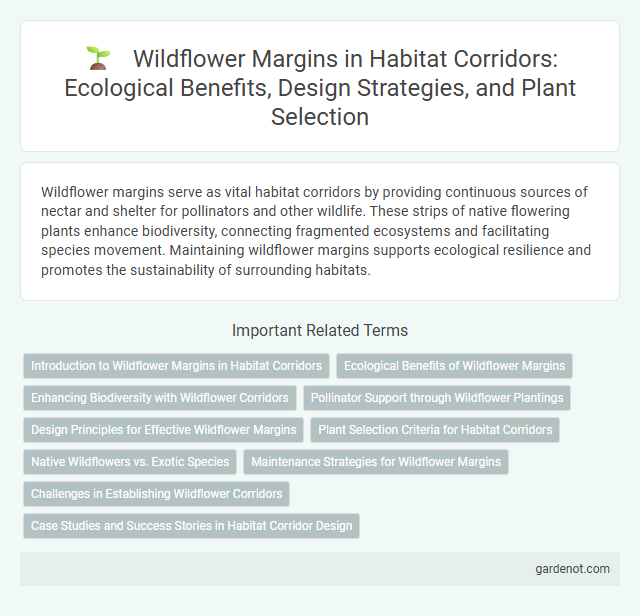Wildflower margins serve as vital habitat corridors by providing continuous sources of nectar and shelter for pollinators and other wildlife. These strips of native flowering plants enhance biodiversity, connecting fragmented ecosystems and facilitating species movement. Maintaining wildflower margins supports ecological resilience and promotes the sustainability of surrounding habitats.
Introduction to Wildflower Margins in Habitat Corridors
Wildflower margins in habitat corridors serve as vital refuges for pollinators, insects, and small wildlife, enhancing biodiversity by providing continuous floral resources and shelter. These margins create essential ecological linkages between fragmented habitats, enabling species movement and genetic exchange across landscapes. Incorporating native wildflower species tailored to local conditions maximizes their effectiveness in supporting ecosystem resilience and promoting long-term habitat connectivity.
Ecological Benefits of Wildflower Margins
Wildflower margins enhance biodiversity by providing essential habitats and food sources for pollinators such as bees, butterflies, and native insects. They contribute to soil health through improved nutrient cycling and reduce erosion by stabilizing the ground with deep-rooted plants. These ecological benefits support ecosystem resilience and promote natural pest control in adjacent agricultural landscapes.
Enhancing Biodiversity with Wildflower Corridors
Wildflower corridors create essential habitat margins that support diverse pollinators and wildlife by providing continuous foraging and nesting resources. Planting native wildflowers in these corridors increases floral diversity, boosting insect populations and promoting ecological resilience across fragmented landscapes. Strategic placement of wildflower margins within habitat corridors enhances connectivity, facilitating species movement and genetic exchange critical for long-term biodiversity conservation.
Pollinator Support through Wildflower Plantings
Wildflower margins create vital habitat corridors that enhance pollinator support by providing continuous sources of nectar and pollen throughout the growing season. Diverse native wildflower plantings attract a variety of pollinators, including bees, butterflies, and hoverflies, promoting biodiversity and ecosystem resilience. These corridors improve pollination services for surrounding agricultural landscapes, boosting crop yields and environmental health.
Design Principles for Effective Wildflower Margins
Design principles for effective wildflower margins prioritize native species diversity to enhance pollinator habitats and support local wildlife. Optimal placement involves situating margins along field edges with adequate sunlight and avoiding areas prone to pesticide drift for maximum ecological benefit. Incorporating a variety of flowering periods ensures continuous resources, promoting year-round biodiversity within habitat corridors.
Plant Selection Criteria for Habitat Corridors
Plant selection criteria for wildflower margins in habitat corridors prioritize native species that support local pollinators and wildlife, enhance biodiversity, and adapt well to the specific soil and climate conditions of the corridor. Emphasis is placed on including a diverse mix of perennials and annuals with staggered blooming periods to provide continual food sources throughout the growing season. Selecting plants with deep root systems also aids in soil stabilization and water infiltration, promoting ecological resilience and connectivity.
Native Wildflowers vs. Exotic Species
Native wildflowers in habitat corridors support local biodiversity by providing food and shelter for indigenous pollinators and wildlife, unlike exotic species that may disrupt ecosystem balance. Wildflower margins dominated by native species promote soil health, enhance pollination networks, and maintain genetic diversity crucial for resilient habitats. Incorporating a high percentage of native wildflowers in corridor design significantly improves ecological connectivity and habitat quality.
Maintenance Strategies for Wildflower Margins
Effective maintenance strategies for wildflower margins in habitat corridors include regular mowing outside peak flowering periods to prevent woody plant encroachment and promote diverse species growth. Selective weeding removes invasive species without disturbing native flora, ensuring ecological balance and pollinator support. Seasonal monitoring and adaptive management based on plant health and soil conditions optimize biodiversity and corridor functionality.
Challenges in Establishing Wildflower Corridors
Establishing wildflower corridors faces challenges such as soil degradation, invasive species encroachment, and inconsistent pollinator presence, which hinder native plant growth and biodiversity restoration. Limited funding and land availability restrict large-scale implementation, while climate variability alters flowering times and reduces corridor resilience. Effective management requires coordinated efforts in habitat connectivity, invasive species control, and adaptive monitoring to sustain ecological functions.
Case Studies and Success Stories in Habitat Corridor Design
Wildflower margins have proven effective in habitat corridor design, enhancing biodiversity by providing essential resources and shelter for pollinators and other wildlife. Case studies from the UK, such as the WildPollinator project, demonstrate significant increases in native bee populations and butterfly diversity where wildflower strips were integrated along agricultural landscapes. Success stories highlight the role of native wildflower species in creating resilient ecological networks, supporting ecosystem services, and improving connectivity between fragmented habitats.
Wildflower margin Infographic

 gardenot.com
gardenot.com